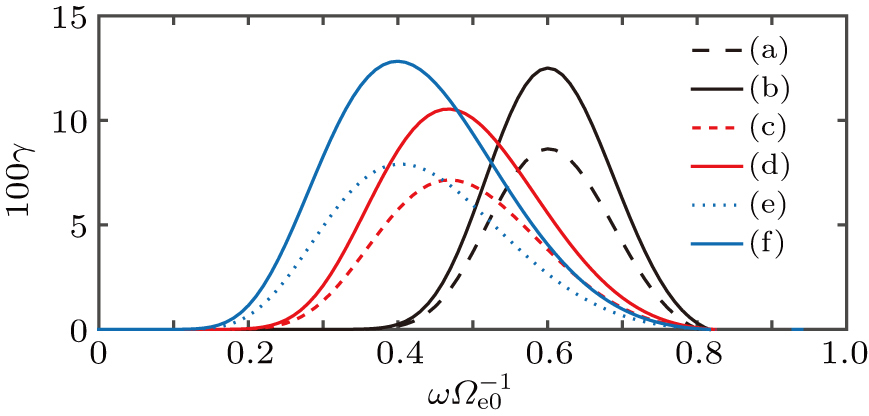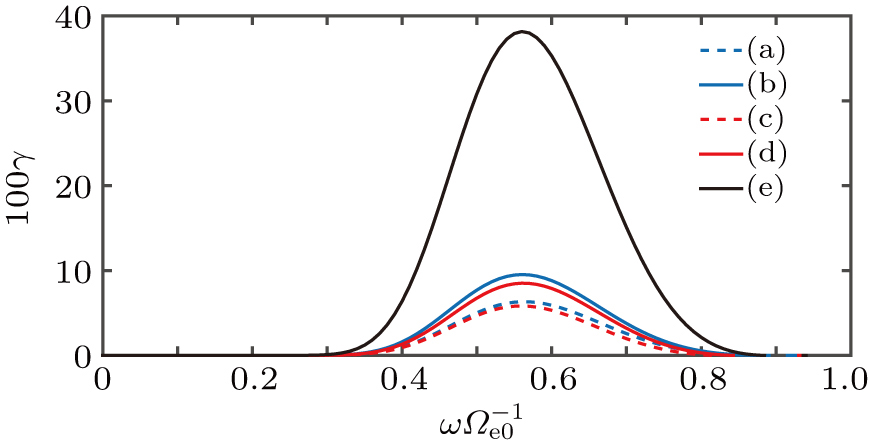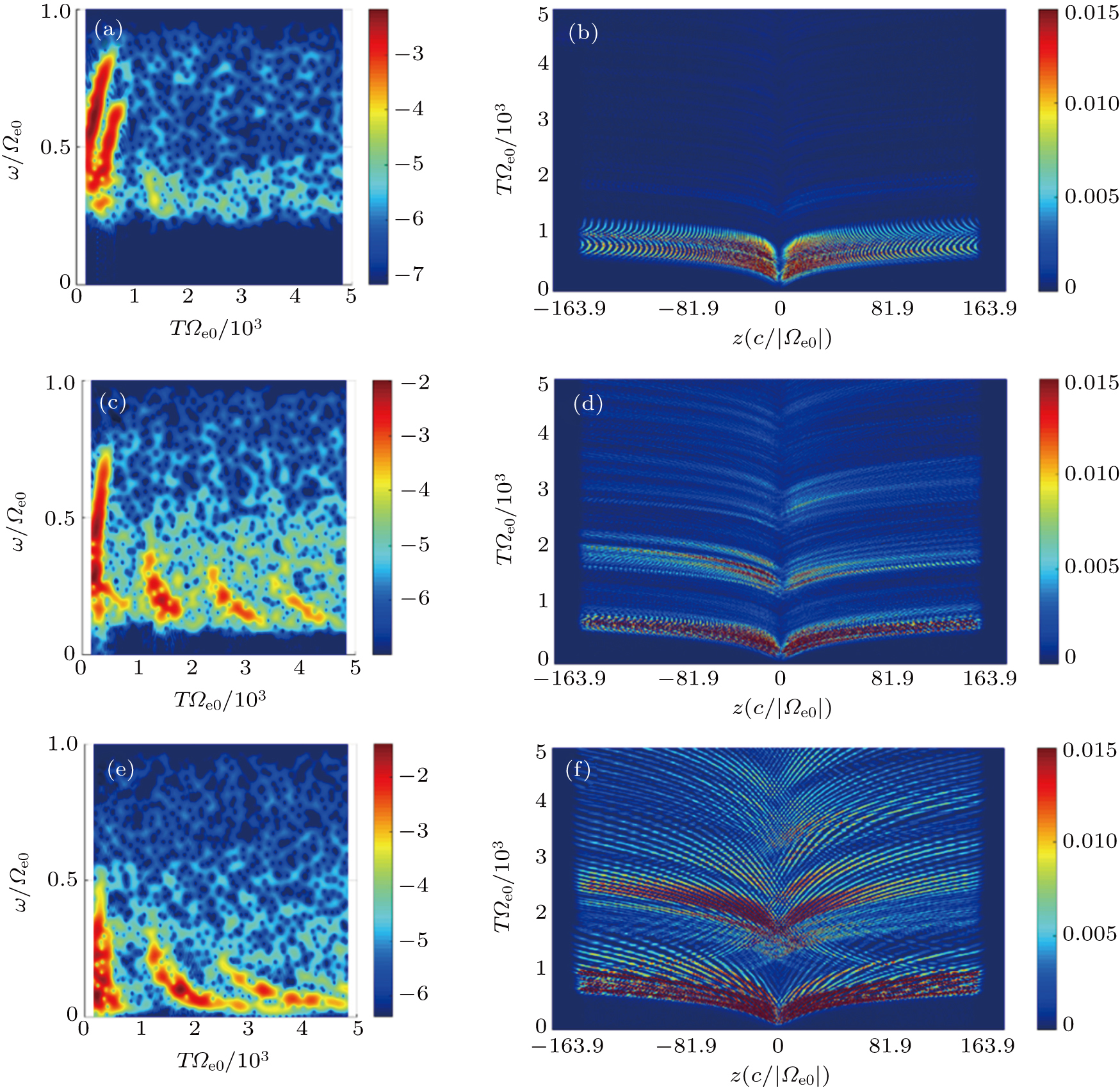† Corresponding author. E-mail:
Project supported by the National Natural Science Foundation of China (Grant Nos. 41674165, 41631071, 41474142, and 41674174) and the China Postdoctoral Science Foundation (Grant No. 2015M570283).
Due to their significant roles in the radiation belts dynamics, chorus waves are widely investigated in observations, experiments, and simulations. In this paper, numerical studies for the generation of chorus-like waves in a launching device, dipole research experiment (DREX), are carried out by a hybrid code. The DREX plasma is generated by electron cyclotron resonance (ECR), which leads to an intrinsic temperature anisotropy of energetic electrons. Thus the whistler instability can be excited in the device. We then investigate the effects of three parameters, i.e., the cold plasma density nc, the hot plasma density nh, and the parallel thermal velocity of energetic electrons, on the generation of chorus-like waves under the DREX design parameters. It is obtained that a larger temperature anisotropy is needed to excite chorus-like waves with a high nc with other parameters fixed. Then we fix the plasma density and parallel thermal velocity, while varying the hot plasma density. It is found that with the increase of nh, the spectrum of the generated waves changes from no chorus elements, to that with several chorus elements, and then further to broad-band hiss-like waves. Besides, different structures of chorus-like waves, such as rising-tone and/or falling-tone structures, can be generated at different parallel thermal velocities in the DREX parameter range.
Chorus waves are whistler mode emissions, which can be commonly observed in the inner magnetosphere and play dominant roles in the radiation belts dynamics.[1–7] The frequency of chorus waves is in the range of electron gyro-frequency in the radiation belts. Thus they can exchange energy with electrons effectively via cyclotron resonances. This mechanism may then explain the enhancement of relativistic electrons in the magnetic storm recovery phase.[8,9] Such waves are also believed to scatter electrons into the loss cone, which may lead to a precipitation of ~ keV electrons.[10] Ni et al. have demonstrated that the formation of the diffuse and pulsating auroras is a result of such precipitation.[11,12] Besides, chorus waves are also supposed to be a cause of the formation of pancake-like electron distributions.[13]
A chorus spectrum generally consists of two bands separated by a gap near the half of the electron gyro-frequency with discrete chirping elements,[14,15] including rising and/or falling tone structures. The two bands have different propagation properties. For example, the lower band is dominated by electromagnetic waves along the ambient magnetic field lines, while the upper band is highly oblique quasi-electrostatic waves.[16,17]
Chorus waves are under further investigation in observations, simulations, as well as ground experiments. Various theoretical and simulation models have been proposed to explain their characteristics in recent decades. A linear theory proposed by Kennel described the amplitude in the initial stage of the whistler instabilities,[18] and nonlinear models were then offered for the nonlinear evolution of these instabilities. For example, Omura et al. obtained the nonlinear wave growth rate in a parabolic ambient magnetic field.[19] They also carried out a series of simulations to explain the formation of the falling tone and the gap. Schriever et al. suggested that the lower band chorus might be the result of wave–wave coupling while the upper band was driven by anisotropic electrons in hundreds of eVs.[20] Liu et al. demonstrated that the two bands were excited by two distinct anisotropic electron populations via a two-dimensional (2D) particle-in-cell (PIC) simulation.[21] However, these models need to be further validated by observations or experiments. Actually some experiments were attempted to excite whistler waves in near-earth space environments. In such an experiment carried out by Helliwell in 1983,[22] coherent very low frequency (VLF) signals were launched into the Earth’s magnetosphere, and amplified by about 30 dB with narrow-band whistler mode emissions being triggered. It was indicated that the results were caused by wave–electron cyclotron resonance. Also in the high-frequency active auroral research program (HFAARP), extremely-low-frequency (ELF)/VLF waves were generated in the magnetosphere,[23] and the triggered emissions were mostly observed under the quiet magnetospheric conditions.
On the other hand, additional to satellite/ground observations and numerical simulations, ground experiments also play an important role in the investigation of chorus waves. Various types of laboratory simulation devices have been built to investigate the fundamental physical processes in the magnetosphere plasmas, such as the large plasma device (LAPD) at University of California, Los Angeles (UCLA) and the collisionless terrella experiment (CTX) at Columbia University. In LAPD experiments, a beam of electrons was launched into the device to generate chorus-like waves with rapid frequency chirping.[24] With different plasma parameters, the spectra of the chorus-like waves showed various structures. In CTX experiments, radial and azimuthal mode structures of plasma waves were excited either by hot electron instabilities or by a broad-band antenna, while a population of energetic electrons was created using electron cyclotron resonance heating.[25]
An experimental device specially designed for simulating radiation belt physics, dipole research experiment (DREX), is under construction at Harbin Institute of Technology (HIT) in China,[26–28] as an important component of China major state facility for fundamental research, space environment simulation research infrastructure (SESRI). It is designed to simulate the basic physical processes in the near-earth space environment by scaling plasmas in laboratory with that in space, and aims to study wave–particle interaction of energetic particles in the radiation-belt-like plasmas. Since chorus-like waves are crucial for such processes, numerical simulations are needed to predict whether the waves can be excited under the designed parameters of DREX. In this paper, we carry out a numerical research with DREX parameters and designed experiment conditions using a hybrid code to study chorus-like waves’ excitation process and their characteristics.
The rest of the paper is organized as follows. We describe the simulation code, DAWN, and simulation setup in Section
We here use a hybrid code named DAWN[29] to simulate the wave excitation in DREX. The ions are assumed to be fixed due to their slower time scale compared to that of electrons. The cold electrons are modeled by a group of linearized fluid equations, and the hot energetic electron populations are handled by PIC schemes. The distribution of the hot electrons is assumed to be bi-Maxwellian with a number density nh
The plasma in DREX is designed to be generated by an electron cyclotron resonance (ECR) source as well as a biased cold cathode discharge, which gives the energetic electrons an essential temperature anisotropy represented by the anisotropy factor A(≡ T⊥/T∥ − 1). By varying the power of the ECR source, one can control the temperature anisotropy A in a wide range (e.g., from 1 to 20 or higher). The collisional frequency of the electrons with neutral particles is ~ 105 s−1 while the gyro-frequency of the electron is ~ 1010 s−1, which is much larger than the collisional frequency. Thus the plasma can be treated as collisionless in at least ~ 105 gyro-periods, while the simulation time in this work is ~ 5000 gyro-periods (which is about the designed experiment duration). Therefore the electron is collision-free and the temperature anisotropy can be held in the simulation period to drive the whistler instability. There are mainly 3 parameters that can significantly influence the whistler instability, namely, the cold and hot plasma densities, as well as the parallel thermal velocity, according to Kennel.[23] Satellite observations have indicated that chorus waves have a higher occurrence rate outside the plasmasphere where the plasma density is lower. So the background cold plasma density may play a significant role in the generation of chorus waves. Under the DREX designed parameters, the gyro-frequency of electrons Ωe0 is about 7.025 × 109 s−1, and the cold plasma density can be in the range of 1017–1018 m−3, with the plasma frequency ωpe of 2.5–8 Ωe0. The maximum linear wave growth rate γmax, a significant parameter in the generation process of chorus wave, largely depends on nh and w∥. γmax increases with the hot plasma density nh. The parallel thermal velocity can determine the frequency of the maximum wave growth rate ω(γmax) and the number of electrons that are resonated with the waves. Effects of the three parameters will be investigated separately in the simulation by varying one while fixing the other two. The DREX plasma parameters and the simulation parameters are listed in Tables
| Table 1.
The plasma parameters in DREX. . |
| Table 2.
Common simulation parameters. . |
In this subsection, we will discuss the temperature anisotropy threshold (AT) that is needed to excite chorus-like waves in the DREX under different cold plasma densities (corresponding to different ωpe). Generally, the chorus waves are more frequently observed in the radiation belts out of the plasmasphere where the plasma density is much lower. Can chorus-like waves be generated more easily with lower plasma densities in DREX? To study this issue, we carry out a series of simulations to investigate the relation between temperature anisotropy threshold AT and the plasma density. In our simulations, the parallel thermal velocity and density of the energetic electrons are fixed and their perpendicular thermal velocities change in a wide range until chorus-like waves are generated at a certain ωpe. Thus the temperature anisotropy threshold AT can be obtained. The simulation results are shown in Fig. 
The results of Fig.
 | Fig. 2. (color online) The linear wave growth rate γ in different cases (corresponding to those in Fig. |
From the above results we can conclude that with a lower ωpe, corresponding to a lower cold plasma density, chorus-like waves can be generated with a much smaller AT, which indicates that smaller power is needed to drive this temperature anisotropy. In other words, chorus waves can be more easily excited in low density plasmas with other parameters fixed. It is coincident with the observations that chorus waves have a high occurrence rate outside the plasmasphere where the plasma density is low. Besides, according to the linear theory, the width of the linear wave growth rate peak is larger with a higher plasma density. Thus more free energy is needed to generate chorus-like waves in high density plasmas. To excite chorus-like waves in future DREX experiments, low plasma density should be applied.
As predicted by the linear theory, the linear wave growth rate increases with the hot plasma density. In this subsection, we demonstrate the influence of the hot plasma density on the generation of chorus waves in DREX. First, we study AT under different hot plasma densities in four simulations, and the results are shown in Figs.
Then we continue to increase the hot plasma density on the basis of Fig.
We calculate the linear wave growth rate for the cases in Fig.
In this subsection, we study the influence of the parallel temperature on the excitation of chorus-like waves. As mentioned above, AT is between 24 and 35 in the case of ωph = 1, w∥ = 0.025, and ωpe = 8, as shown in Figs.
 | Fig. 5. (color online) Maximum linear wave growth rate as a function of the parallel thermal velocity. |
Simulation results of the normalized electron power spectrum densities varying in the frequency domain with different parallel thermal velocities, as well as the spatial profile and time evolutions of the wave amplitude with different parallel thermal velocities, are shown in Fig.
As a brief summary, the simulation parameters and wave properties of the cases in this paper are listed in Table
| Table 3.
Simulation parameters and wave properties of all the cases in this work. . |
A hybrid simulation is used to study the generation of chorus-like waves in the establishing device DREX. Besides the temperature anisotropy, there are also three other main parameters that significantly influence the generation of chorus, i.e., the cold plasma density (nc), the hot plasma density (nh), and the parallel thermal velocity of energetic electrons. We demonstrate the effect of the three parameters on the generation of chorus-like waves by three groups of simulations, and the main conclusions are as follows. (i) In the designed DREX parameter regime, different structures of chorus-like waves, the rising-like, the falling-like, and the mixed, can be generated. (ii) A low ωpe which corresponds to a low cold plasma density can generate chorus-like waves with very small anisotropy threshold AT. (iii) A high hot electron density can lower the threshold. However, for certain temperature anisotropy, only hiss-like waves are excited at a very high hot electron density.
| [1] | |
| [2] | |
| [3] | |
| [4] | |
| [5] | |
| [6] | |
| [7] | |
| [8] | |
| [9] | |
| [10] | |
| [11] | |
| [12] | |
| [13] | |
| [14] | |
| [15] | |
| [16] | |
| [17] | |
| [18] | |
| [19] | |
| [20] | |
| [21] | |
| [22] | |
| [23] | |
| [24] | |
| [25] | |
| [26] | |
| [27] | |
| [28] | |
| [29] | |
| [30] | |
| [31] |








